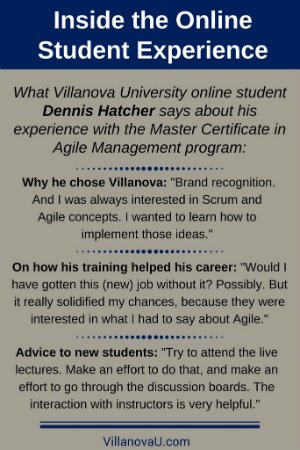
IT Professional Finds Motivation, Career Growth Through Master Certificate in Agile Management
IT Professional Finds Motivation, Career Growth Through Master Certificate in Agile Management

Last Updated August 23, 2023
Dennis Hatcher had not even finished earning his Master Certificate in Agile Management-IT from Villanova University when his training began to pay off.
After completing two of the three required courses toward his master’s certificate, Hatcher was hired to fill a position as IT Manager with Philadelphia-area medical device manufacturer Pulse Technologies Inc. He said that what he learned during his online classes at Villanova helped him get the job.
“A lot of (answers) to the questions that took place during the interview process came directly from these courses,” Hatcher said. “This class has helped me land a position that’s going to basically pay for (the Agile training) before I even get finished.”
The new position was exactly what Hatcher had hoped to find: an opportunity to implement Agile Scrum concepts at a successful firm. It didn’t hurt, he said, that the office was only a 20-minute drive from his house outside Philadelphia.
Master Certificate Motivation
Even before he learned about the position at Pulse, though, Hatcher made the decision to expand his professional skillset by seeking a Master Certificate in Agile Management-IT from Villanova. He was a long-time believer in Scrum software development and Agile methodology, and as an independent contractor and small business owner at the time, he wanted be able to offer clients a range of proven ideas for process improvement.
“I spent years reading about Scrum and Agile,” he said. Hatcher discovered the IT-specific Agile Management program while searching for more information on the topic, and then called an enrollment specialist to learn more about the course offerings.
After that phone call, Hatcher decided he would “take a look.”
“If nothing else, I’ll take the first course, see what it’s about, see what I’m missing and fill in any gaps in my knowledge about the subject,” he said.
Path Toward Career Advancement
Hatcher’s first attempt to implement Agile-related ideas and streamline processes occurred in 2011, while employed at a healthcare advertising agency.
Hatcher recalled that he and a co-worker were brainstorming ideas to improve workflow and project management procedures at the agency when the topic turned to Scrum. As he worked his way up in the agency from software developer to Director of Technology, Hatcher attempted to implement what he called a “small-scale version” of Scrum in the IT department.
“We started to do a daily standup, things like that, but it wasn’t truly Agile,” Hatcher said. “It was more coordination than anything else. We made some improvements in communication, at least.”
After a few years of agency life, Hatcher decided to found his own IT services company, Digitally Inclined Solutions. He took on a number of contracts, and was encouraged enough with the progress of his company to invest in advanced Agile training and education.
Then, he and his wife found out they were expecting their second child.
Hatcher decided it was time to find a more-stable, rewarding position with a company where he could earn a steady paycheck and enjoy some well-earned vacation time.
He also knew he wanted to work someplace where he could implement his deeper knowledge of Agile concepts.
As Hatcher prepared to enter his third and final Agile Management course during the summer of 2016, he interviewed with Pulse Technologies. He said his interviewers were intrigued by his ideas to implement Agile processes at Pulse in order to improve the IT department’s productivity.
“The president of the company, his eyes opened wide,” Hatcher recalled. “He said, ‘We need to redefine our process here, at least in the IT section of the company.’ And the company’s been around 20-something years. It’s not a new company. It’s in a good sector, medical devices. He even asked the name of the course and was taking notes about the course itself.”
Pulse offered Hatcher the job, he said, before he made it back home from the interview. He started in early August, and he completed his final coursework toward his Master Certificate in Agile Management-IT in October. His next step is to sit for the PMI-ACP® exam, which he plans to do before the end of the year.
Making a Plan of Action
In preparation for his new job as IT Manager, Hatcher put together two documents based on his Agile training.
One document was an implementation plan that set incremental goals at the 30-, 60-, 90- and 120-day mark with the company. In it, Hatcher laid out many of the Agile concepts that he learned in detail during his first two courses at Villanova. It served as an Agile primer for his new co-workers, laying the groundwork for upcoming potential change.
The other document he brought to Pulse was a written plan of action. In it, Hatcher detailed how he intended to help the team implement Agile concepts.
Here is a summary of Hatcher’s plan of action:
- Get acquainted – Hatcher set up meetings with the IT team, managers and stakeholders at Pulse Technologies who could influence outcomes in his department. Knowing the importance of earning buy-in from management from the top down, Hatcher did not come in expecting to make immediate, sweeping changes. He knew it would take time to learn what worked and how it worked, and that it would take time to get a feel for personalities, individual strengths and cultural challenges.
- Discovery – The next step was to learn as much as possible about Pulse by delving into current procedures. What was the workload for the IT team? What did the flow of information look like? How was the workload managed? How were requirements gathered and prioritized? Hatcher sought to identify gaps and bottlenecks in the process.
- Develop and communicate a new plan – After the discovery phase, Hatcher formulated a customized plan for streamlining processes using Agile concepts. He identified what was working already and folded it into the plan. He also identified what was not working and sought ways to improve it. He surveyed his team and stakeholders to determine where and how the Agile mindset could be fostered. Then, he created a team charter and a working agreement for the IT department.
What came out of the initial stage of Hatcher’s implementation of Agile ideas at Pulse was a “hybrid version,” a combination of various strategies, including Agile and Scrum, catering to the specific needs at his new company.
The immediate goal, Hatcher said, was to implement “the quickest fixes that bring the biggest value” in Pulse’s IT department. The long-range goal, he said, is to shape an organization that is positioned to make incremental adjustments to stay ahead of changes in the industry or within the company.
So far, so good.
“My boss is all for it,” he said. “He sees the change that I’m bringing. … It’s going well. It’s going very well.”
PMI-ACP is a registered mark of the Project Management Institute, Inc.





